Secret Villages of Portugal: Beyond Lisbon and Porto
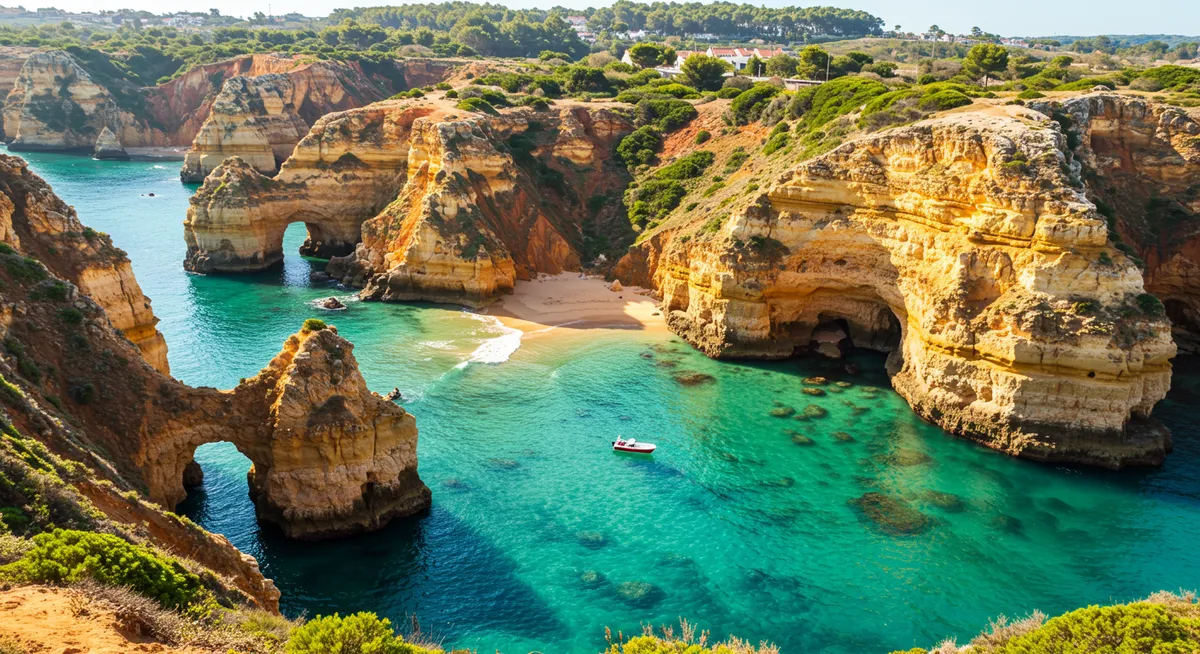
Secret Villages of Portugal: Beyond Lisbon and Porto
While Portugal's coastal cities and Algarve beaches draw millions of visitors annually, the soul of this ancient nation often resides in its hidden villages. Perched atop rocky outcrops, nestled in verdant valleys, or enclosed within medieval walls, these settlements offer glimpses into Portugal's rich history and traditions that many travelers miss. From stone villages seemingly frozen in time to whitewashed towns gleaming in the Iberian sun, this guide unveils Portugal's most enchanting hidden gems where authentic experiences await those willing to venture beyond the well-trodden tourist path.
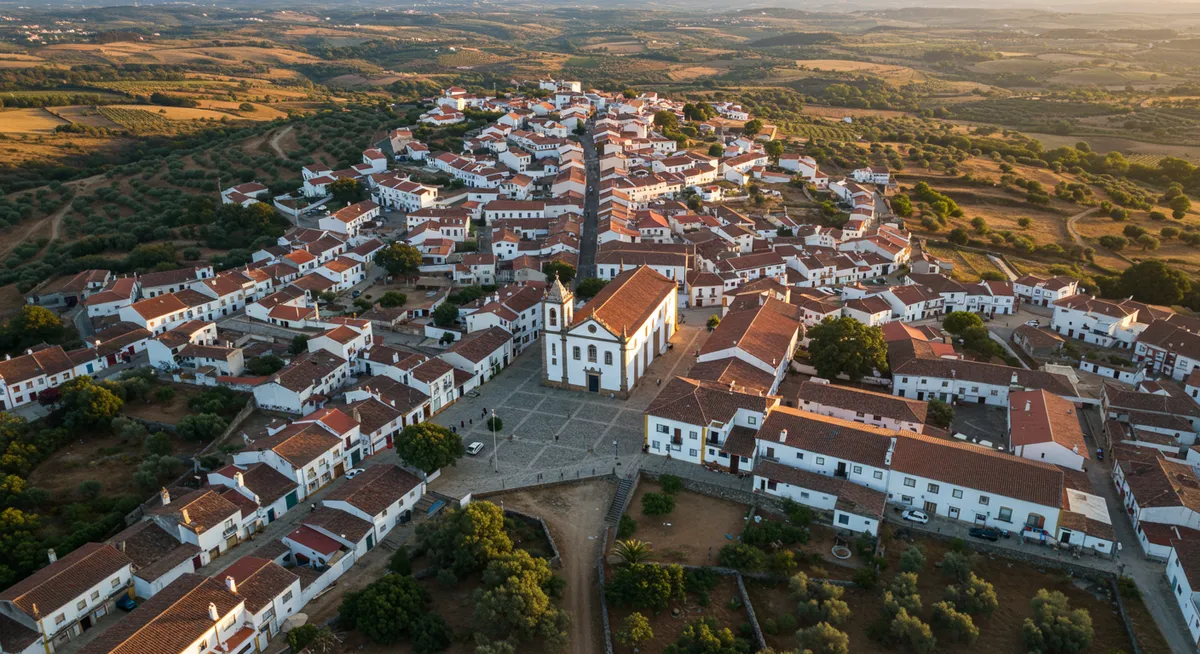
1. Óbidos: The Wedding Gift Village
Encircled by imposing medieval walls, Óbidos stands as one of Portugal's most picturesque hidden treasures. Though not entirely unknown to tourists, this charming village retains an authentic atmosphere that transports visitors centuries back in time. Gifted by King Dinis to Queen Isabel in 1282 as a wedding present, Óbidos became part of the Queen's Estate, a tradition that continued for generations of Portuguese queens, earning it the nickname "The Wedding Gift."
What Makes It Special
- Complete Medieval Walls: Visitors can walk the entire circumference of the perfectly preserved 14th-century walls
- Flower-Bedecked Streets: Narrow cobblestone alleys lined with whitewashed houses adorned with colorful bougainvillea
- Literary Heritage: Home to an enchanting "Literary Town" concept with bookshops in unexpected places, including a converted church
- Ginjinha Tradition: Famous for serving the traditional sour cherry liqueur in edible chocolate cups
Local Experiences
Walk the medieval walls for panoramic views of terracotta rooftops, whitewashed buildings, and the surrounding countryside. Visit during the International Chocolate Festival (usually held in March) to sample creative confections from master chocolatiers. Stay in the castle, now converted into a luxury pousada (historic hotel), for a truly memorable experience. Sample ginjinha (sour cherry liqueur) served in chocolate cups from small shops along the main street—a delicious local tradition.
Getting There
Óbidos is located in central Portugal, about 80 km (50 miles) north of Lisbon. It's easily accessible by car via the A8 highway or by bus from Lisbon's Campo Grande station (approximately 1 hour). While the village itself is car-free, there's ample parking outside the walls.
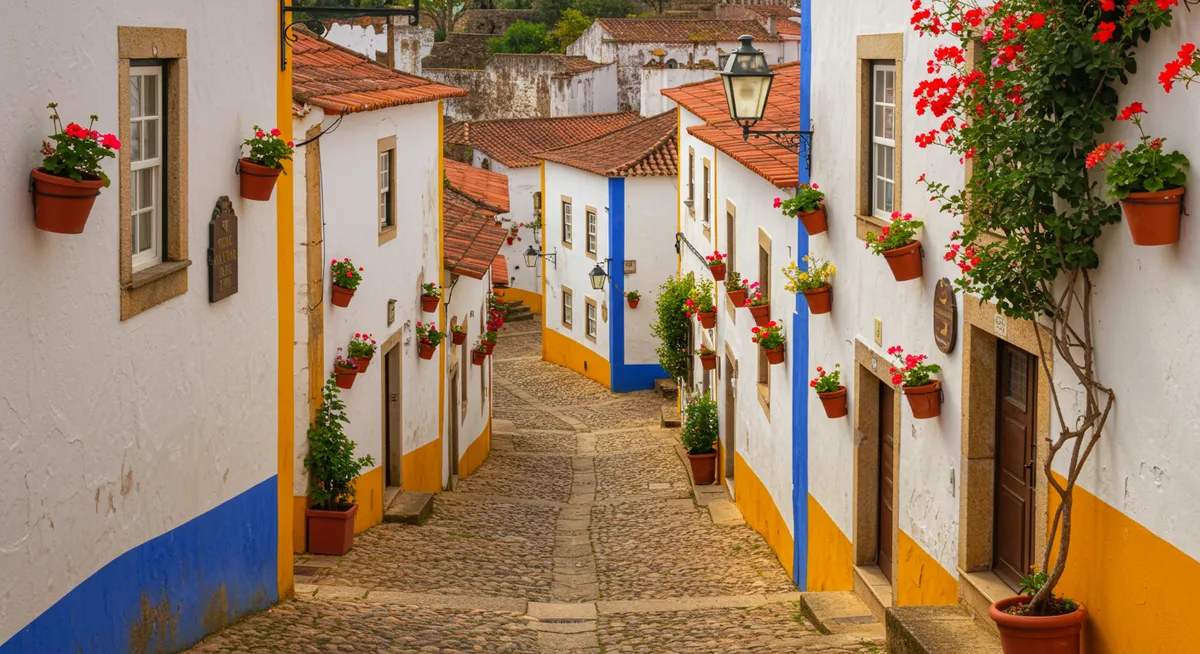
2. Monsanto: The Village of Boulders
Declared "the most Portuguese village in Portugal" in 1938, Monsanto presents one of the most extraordinary settlements in Europe. Built among, around, and sometimes under massive granite boulders on the steep slopes of a mountain, this village seems to grow organically from the rocky landscape. Houses incorporate the enormous rocks as walls, foundations, and even roofs, creating a unique harmony between human habitation and natural elements.
What Makes It Special
- Boulder Integration: Houses built ingeniously incorporating massive granite boulders into their structure
- Ancient History: Inhabited since Paleolithic times with Roman, Visigothic, and Moorish influences
- Mountaintop Castle: The ruins of a Templar castle crown the village, offering spectacular panoramic views
- Time Capsule: Traditional way of life continues with limited modern development
Local Experiences
Wander the narrow, winding streets to discover how buildings have been constructed around and under massive boulders. Hike to the ruins of the 12th-century Templar castle at the summit for panoramic views extending into Spain. Visit the village during the Festa das Cruzes (Festival of the Crosses) in May when locals decorate clay pots with flowers and parade through the streets. Enjoy a meal at a local tavern serving traditional Portuguese dishes like migas (bread-based dish) with pork and wild asparagus.
Getting There
Monsanto is located in central Portugal near the Spanish border, about 225 km (140 miles) northeast of Lisbon. It's best reached by car, as public transportation options are limited. The village streets are extremely steep and narrow, so comfortable walking shoes are essential.
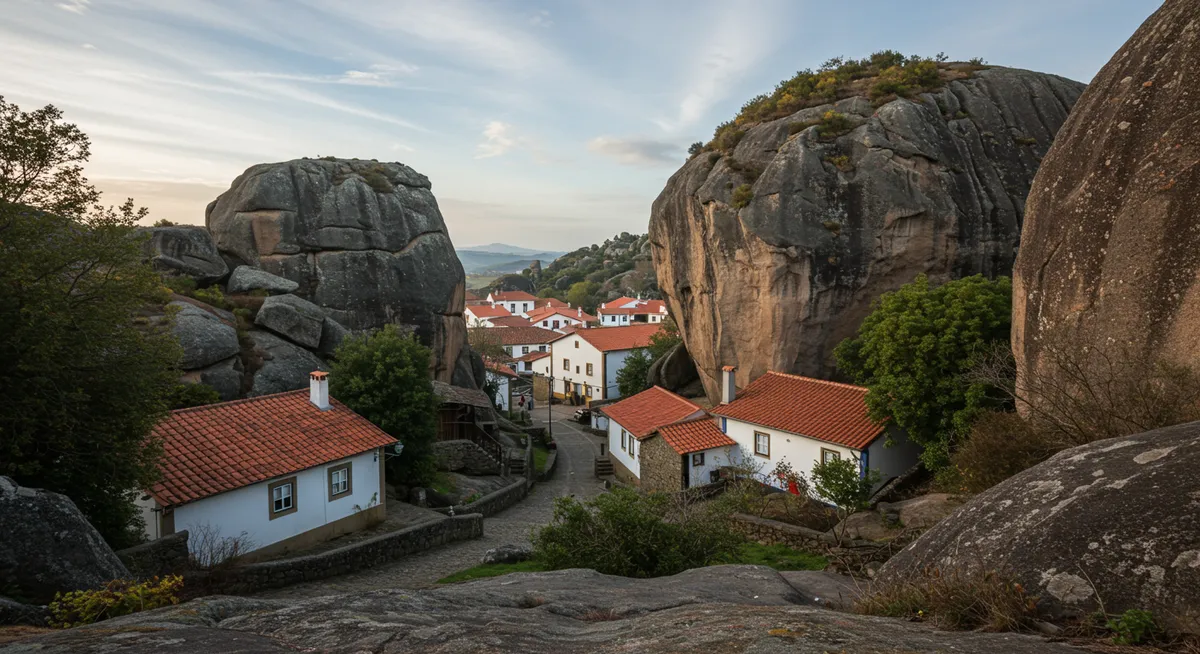
3. Monsaraz: Fortified Hilltop Perfection
Perched majestically atop a hill in Portugal's Alentejo region, Monsaraz stands as a perfectly preserved medieval village enclosed by sturdy stone walls. Its strategic position overlooking the Guadiana River and the Spanish border explains its historical importance and impressive fortifications. With whitewashed houses lining narrow cobblestone streets, this village offers visitors a pristine glimpse into Portugal's past while providing spectacular views of the surrounding countryside and the vast Alqueva reservoir.
What Makes It Special
- Intact Fortifications: Complete medieval walls encircling a perfectly preserved village
- Whitewashed Beauty: Harmonious architecture with white lime-washed houses and slate decorations
- Dark Sky Reserve: Located in the world's first Starlight Tourism Destination, offering exceptional stargazing
- Megalithic Heritage: Surrounded by ancient stone circles and prehistoric monuments
Local Experiences
Explore the medieval castle and walk along the walls for panoramic views of the Alqueva Dam (Europe's largest reservoir) and the surrounding plains. Visit the Igreja Matriz (main church) with its stunning painted ceiling and unique tilework. Participate in stargazing activities under some of Europe's darkest skies, officially designated as a Starlight Tourism Destination. Sample traditional Alentejo cuisine, known for its bread-based dishes, olive oils, and bold red wines at local taverns.
Getting There
Monsaraz is located in the Alentejo region of eastern Portugal, about 170 km (105 miles) east of Lisbon. It's best reached by car, as public transportation options are limited. The village itself is pedestrianized, with parking available just outside the walls.
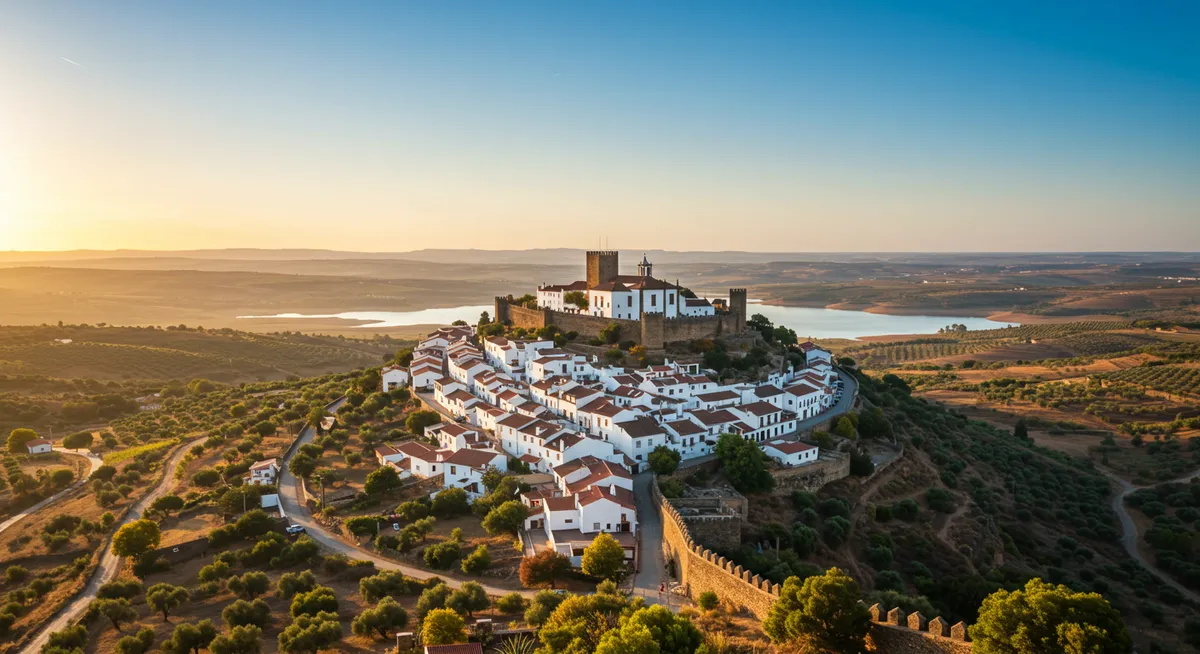
4. Piódão: The Nativity Scene Village
Hidden deep in the Serra do Açor mountains of central Portugal, Piódão appears like a nativity scene come to life. This remote schist village, with its houses built of locally quarried slate-like stone, cascades down a steep hillside in perfect harmony with its rugged surroundings. The blue-trimmed doors and windows stand out against the gray stone, creating a distinctive and harmonious aesthetic that has earned Piódão a place among Portugal's network of Historic Villages.
What Makes It Special
- Schist Construction: Built entirely of local schist stone, creating a rare architectural uniformity
- Isolation Preserved: Remote location has preserved traditional ways of life and building methods
- Blue Accents: Doors and windows painted bright blue, traditionally the only color available to local villagers
- Water Heritage: Ingenious system of communal fountains and water channels throughout the village
Local Experiences
Wander the winding, narrow lanes that follow the contours of the hillside, admiring the masterful stonework of houses built without mortar. Visit the Igreja Matriz (parish church), notably the only whitewashed building in the village, standing out against the sea of schist. Sample regional delicacies like chanfana (goat stew) and Serra da Estrela cheese in local restaurants. Hike the surrounding mountain trails to discover waterfalls, natural swimming pools, and panoramic viewpoints.
Getting There
Piódão is located in central Portugal, about 230 km (143 miles) northeast of Lisbon. It's best reached by car, as public transportation is extremely limited. The final approach involves winding mountain roads, and the village itself is pedestrianized with parking at the entrance.
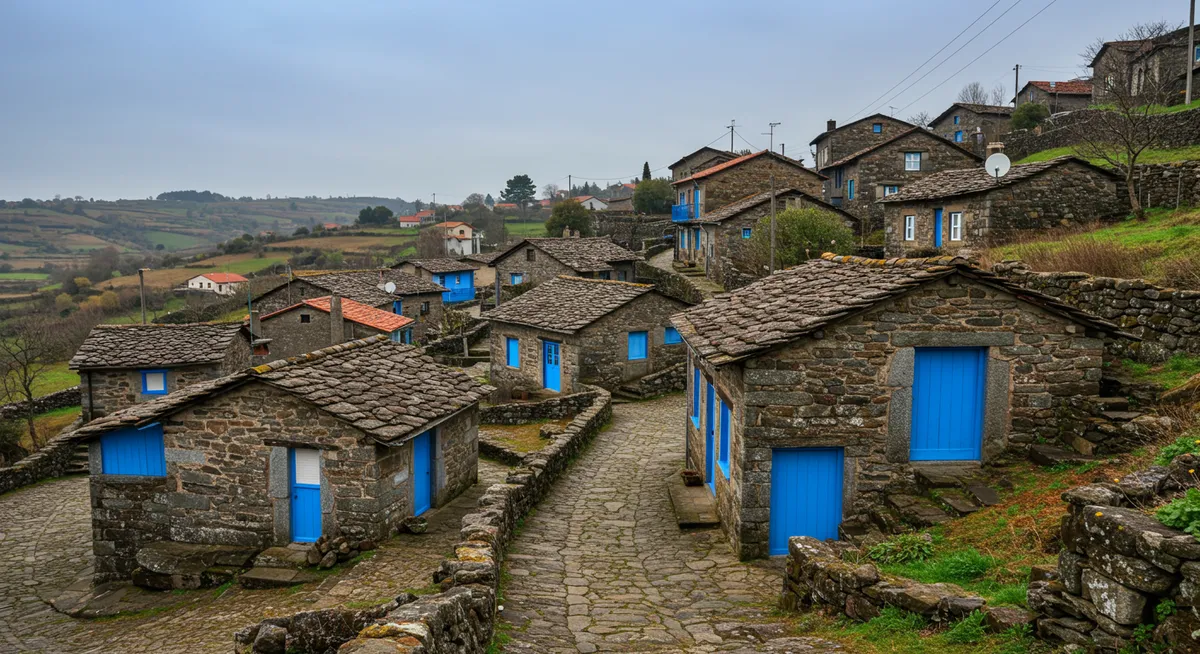
5. Sortelha: Medieval Stone Fortress
Perched atop a rocky outcrop near the Spanish border, Sortelha stands as one of Portugal's most impressive walled villages. Encircled by formidable granite walls and dominated by a 13th-century castle, this medieval settlement appears largely unchanged since the Middle Ages. Massive granite boulders emerge throughout the village, sometimes incorporated into the houses themselves, creating a surreal landscape where nature and human construction merge seamlessly.
What Makes It Special
- Complete Medieval Preservation: One of Portugal's most intact medieval villages with minimal modern intrusions
- Striking Castle: 13th-century fortress built atop massive granite outcroppings
- Boulder Integration: Houses and streets incorporate natural granite formations
- Dramatic Setting: Perched at 760 meters altitude with panoramic views of the surrounding countryside
Local Experiences
Explore the medieval castle ruins and walk the complete circuit of walls for stunning views of the granite houses within and the expansive countryside beyond. Visit the Pelourinho (pillory) in the main square, a symbol of the village's historical administrative importance. Stop at Casa do Povo for traditional products including chestnut-based treats, reflecting the region's abundant chestnut groves. Attend the annual Medieval Fair (usually in July) when the village comes alive with period costumes, music, and food.
Getting There
Sortelha is located in northeastern Portugal, about 300 km (186 miles) from Lisbon. It's best reached by car, as public transportation options are extremely limited. The village is small and entirely pedestrianized, with parking available just outside the walls.
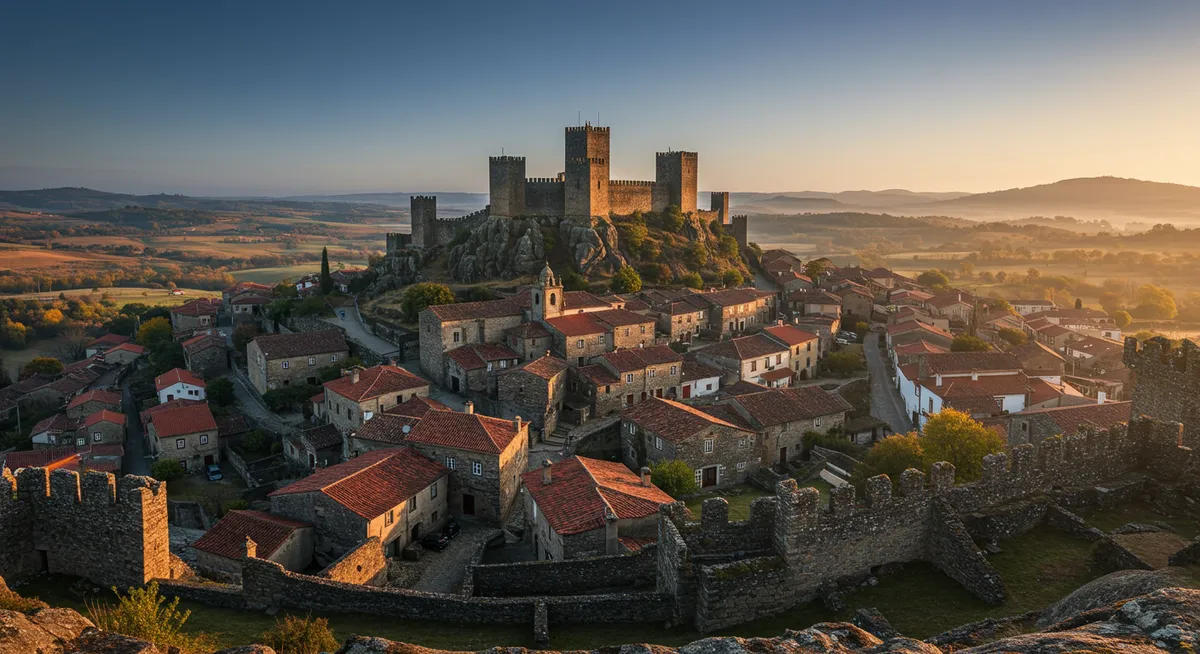
6. Marvão: The Eagle's Nest
Dramatically situated on a 862-meter-high crag overlooking the vast plains of the Alentejo region, Marvão has been described as "the most spectacular fortress town in Portugal." Completely encircled by imposing 13th-century walls, this village offers breathtaking panoramic views extending across Portugal and into neighboring Spain. Its strategic defensive position made it historically important, while today its isolated location has preserved its authentic character and medieval layout.
What Makes It Special
- Spectacular Vistas: Offering some of the most dramatic views in Portugal from its hilltop position
- Impregnable Fortress: Complete medieval walls enclose a village that was never successfully conquered
- Moorish Heritage: Named after Ibn Marwan, a Moorish leader who used it as a refuge
- Unspoiled Authenticity: Limited development has preserved its historical character
Local Experiences
Walk the complete circuit of medieval walls for constantly changing panoramic views across two countries. Visit the 13th-century castle with its impressive cistern and the Municipal Museum housed within, showcasing the area's rich archaeological heritage. Stay for sunset when the whitewashed buildings glow golden and the shadows lengthen across the plains below. Time your visit for the annual Al-Mossassa festival (usually in October), celebrating the village's Moorish heritage with music, food, and historical reenactments.
Getting There
Marvão is located in eastern Portugal near the Spanish border, about 225 km (140 miles) east of Lisbon. It's best reached by car, though limited bus service connects it to nearby towns. The village is pedestrianized, with parking available just outside the walls.
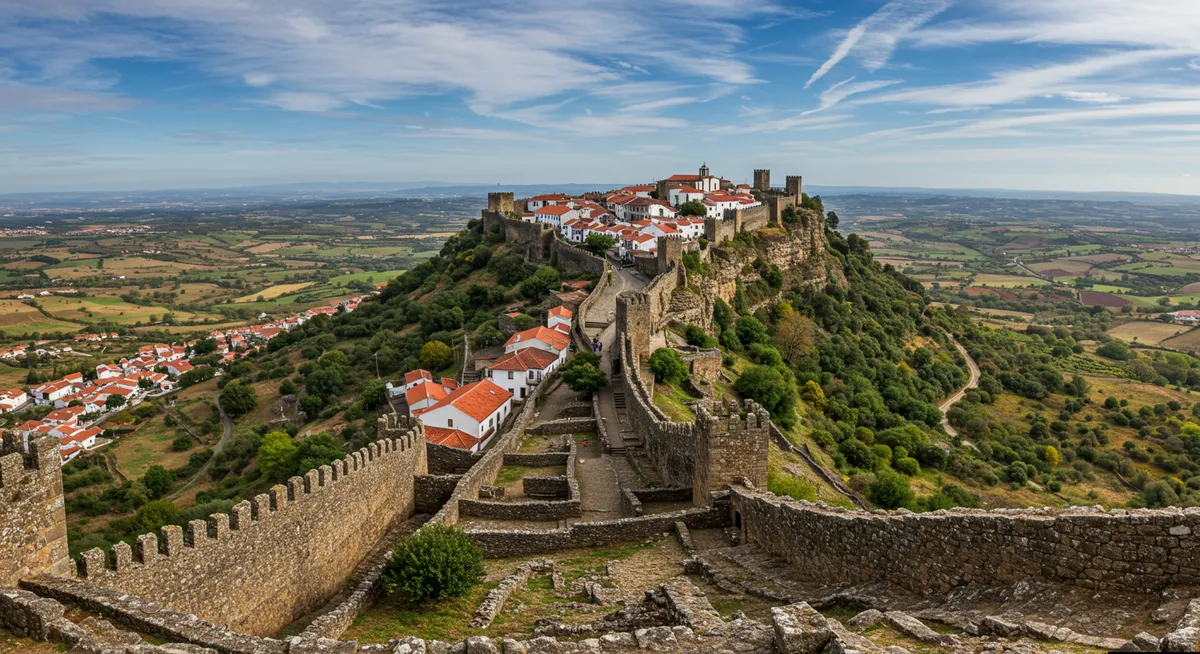
7. Almeida: The Star Fortress
Unlike most villages on this list, Almeida's uniqueness comes not from its mountainous setting but from its extraordinary defensive architecture. This border garrison town is encircled by an impressive star-shaped fortress, one of the finest examples of 17th-century military engineering in Europe. From above, the twelve-pointed star design is striking—a sophisticated defense system of walls, moats, and bastions designed to resist artillery attacks during an era when the Spanish border represented a constant threat.
What Makes It Special
- Star-Shaped Fortifications: One of Europe's best-preserved examples of trace italienne (star fort) military architecture
- Double Defensive Walls: Complete system of bastions, ravelines, moats, and gates remains intact
- Napoleonic History: Site of a famous 1810 siege during the Peninsular War
- Underground Passages: Network of tunnels and chambers built below the fortress
Local Experiences
Walk the complete circuit of the star-shaped ramparts, measuring nearly 2.5 km, for views of the village within and the surrounding countryside. Visit the Military History Museum housed in the former artillery barracks to learn about the fortress's strategic importance. Explore the impressive ruins of the Castle and Military Governor's House, dramatically damaged by a gunpowder explosion during the Napoleonic siege. Attend the annual Historical Reenactment (usually in August) commemorating the 1810 siege with period costumes, weapons demonstrations, and dramatic performances.
Getting There
Almeida is located in northeastern Portugal near the Spanish border, about 340 km (211 miles) from Lisbon. It's best reached by car, though limited bus service connects it to nearby cities. The village within the fortress is easily explored on foot.
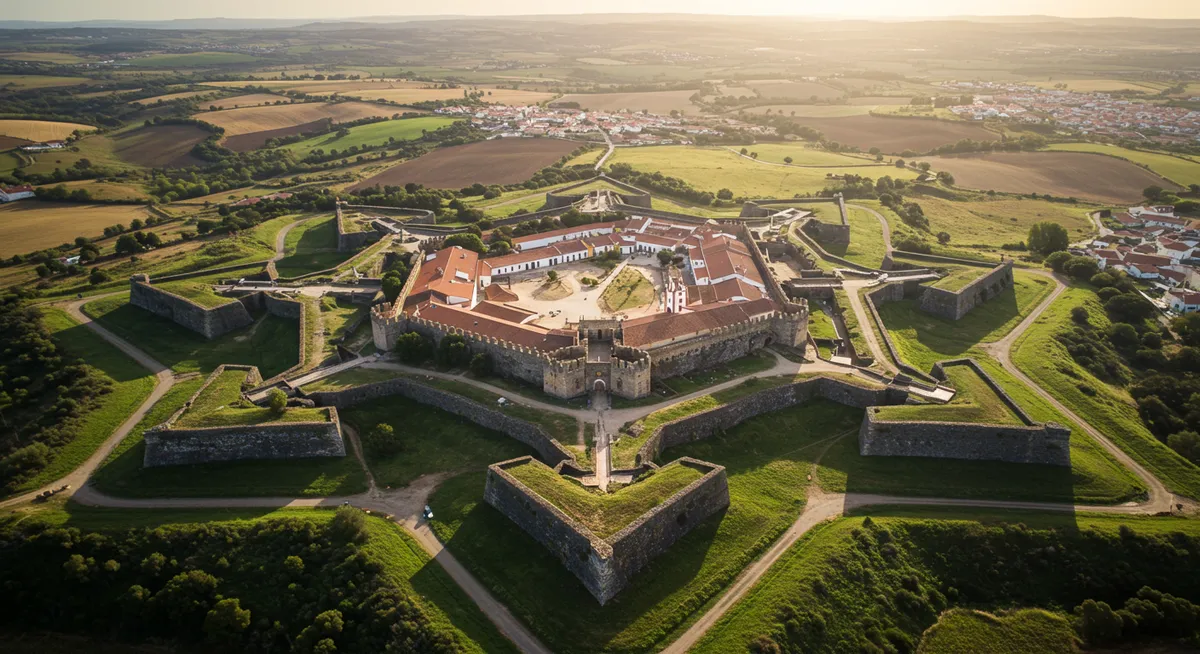
8. Castelo Rodrigo: Hilltop History
Nestled within the foothills of the Serra da Marofa mountain range, Castelo Rodrigo offers visitors a journey through multiple layers of Portuguese history. This fortified hilltop village, once a significant medieval center, tells the story of Portugal's formation through its ancient castle, winding streets, and architectural details spanning centuries. Now peacefully abandoned by most of its inhabitants, the village has become a living museum where visitors can wander through remarkably preserved medieval streets in relative solitude.
What Makes It Special
- Medieval Urban Layout: Perfectly preserved street pattern following the original medieval design
- Jewish Heritage: Important medieval Jewish quarter with star of David carvings still visible on some buildings
- Diverse Architecture: Structures spanning from Moorish influences to medieval, Manueline, and Renaissance styles
- Historic Significance: Site of battles during Portugal's independence struggles against both Spain and Castile
Local Experiences
Explore the ruins of the medieval castle with traces of its violent history—it was partially destroyed in the 17th century during conflicts with Spain. Visit the Palácio Cristóvão de Moura, a Renaissance palace with an interesting historical exhibit about the village. Discover the Old Jewish Quarter, where subtle architectural elements reveal the presence of a once-thriving Jewish community. Sample regional products at the local Antiga Cadeia (Old Prison) now converted to showcase traditional foods including almond pastries, olive oils, and wines from the nearby Beira Interior wine region.
Getting There
Castelo Rodrigo is located in northeastern Portugal, about 330 km (205 miles) from Lisbon. It's best reached by car, as public transportation options are extremely limited. The village is small and pedestrianized, with parking available at the entrance.
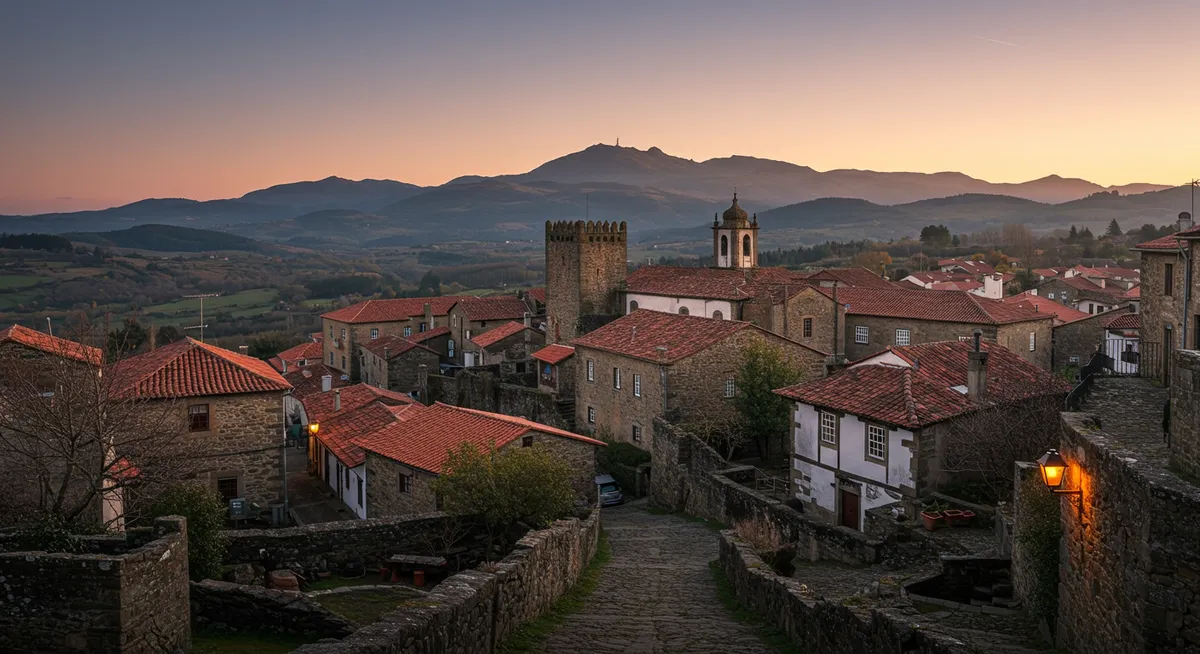
Travel Tips for Visiting Portugal's Hidden Villages
To make the most of your experience exploring these enchanting destinations, consider these practical recommendations:
Best Time to Visit
Spring (April-June) and fall (September-October) offer ideal conditions—pleasant temperatures, fewer crowds, and beautiful landscapes with either spring wildflowers or autumn colors. Summer (July-August) brings hot weather, especially in the Alentejo region where temperatures can exceed 40°C (104°F). Winter visits (November-March) offer a truly local experience with dramatically lower visitor numbers, though some restaurants and attractions may have limited hours. The stone villages can be especially atmospheric in misty or rainy conditions.
Transportation
A car provides the most flexibility for exploring these remote locations, many of which have limited or no public transportation access. Portugal's roads are generally good, though reaching some mountain villages involves narrow, winding routes that require careful driving. Many historic village centers are pedestrianized, so be prepared to park outside and walk in. Consider renting a smaller car, as village streets and parking spaces can be very tight.
Accommodations
For an authentic experience, stay in a pousada (historic hotel often in converted castles or monasteries) or casa de aldeia (village house) within the villages themselves. Many of these historic villages participate in Portugal's "Historic Villages" or "Schist Villages" networks, which maintain quality accommodations in restored traditional buildings. Book well in advance for high season (June-September), especially for weekend stays.
Language
While tourist areas in Portugal often have English-speaking staff, in these authentic villages, a few Portuguese phrases will enhance your experience significantly. Basic greetings, please/thank you, and numbers for shopping are especially useful. Portuguese people generally appreciate visitors making an effort to speak their language, even if just a few basic words.
Pro Tip: Many of these villages host annual festivals celebrating their unique heritage, often featuring historical reenactments, traditional music, and local cuisine. Research festival dates in advance to include these authentic cultural experiences in your itinerary.
Planning Your Portuguese Village Itinerary
These eight villages represent just a sampling of Portugal's hidden treasures. Consider exploring them as part of these regional itineraries:
- Historical Villages Circuit: Combine Sortelha, Castelo Rodrigo, and Almeida with other members of Portugal's "Historical Villages" network for a journey through the country's border history
- Alentejo Exploration: Link Monsaraz and Marvão with other whitewashed villages in this sun-drenched region known for its distinctive cuisine and wines
- Central Portugal Adventure: Connect Piódão with other schist villages in the mountains of central Portugal for experiences of traditional rural life
- Day Trips from Lisbon: Óbidos can be easily visited from the capital, offering a taste of village life without venturing too far
For those looking to expand their hidden gem exploration beyond Portugal, our guides to coastal hidden gems of Spain and medieval villages in Italy offer perfect complements to your Iberian adventures.
Related Hidden Gem Towns Around Europe
If you enjoy discovering Portugal's secret villages, you might also appreciate these similar destinations in other parts of Europe:
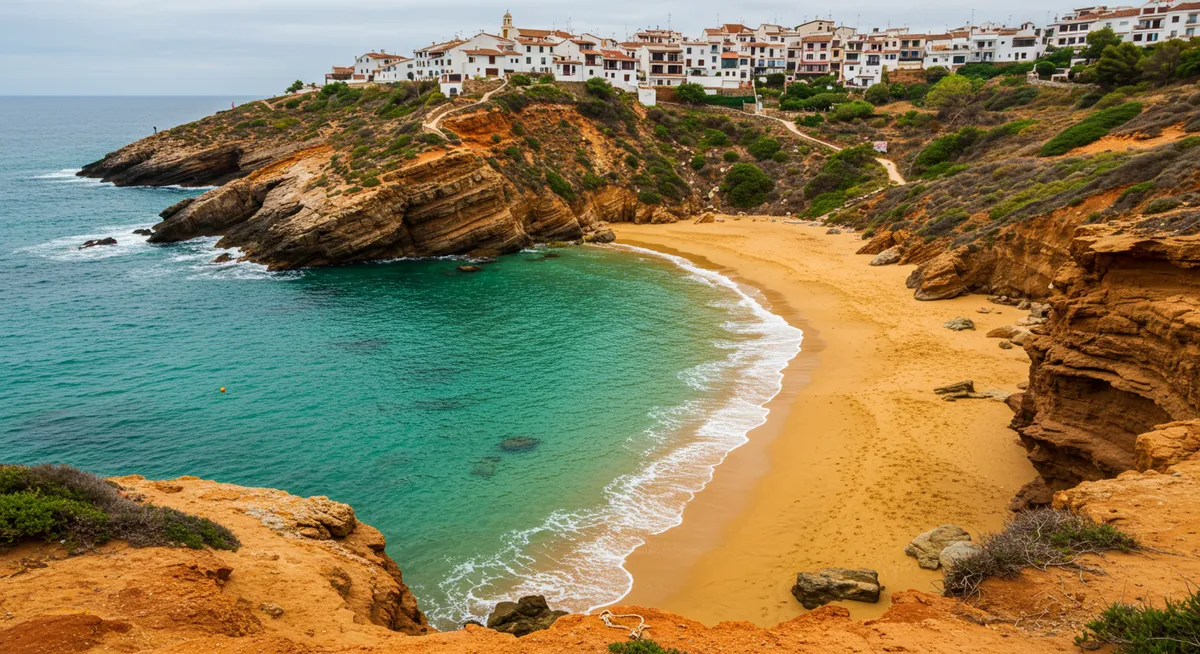
Coastal Spanish Villages
Discover Spain's hidden coastal villages that share Iberian architectural influences and cultural elements with Portugal.

Underrated Medieval Villages in Italy
Explore Italian villages with similar Mediterranean charm and hillside settings to those found in Portugal.

Villages in Southern France
Discover Southern French villages that share similar Mediterranean influences and stone architecture with Portuguese towns.
Explore More Hidden Gem Towns
Discover more enchanting under-the-radar destinations across Europe and beyond.